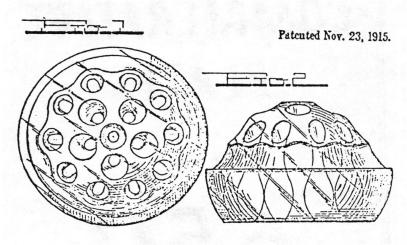Flower Holders - Part III
by Bill Smith
Issue #20 - December 1974
Our Flower Holder for this month is one of Cambridge's less spectacular products. It is, however, a complete and useful line that merits the attention of all serious collectors of Cambridge glass.
 This piece is called a Flower Block, and was cataloged as item
number 2899. At least seven sizes were produced. 2¼, 2¾
3, 3½, 4, 5, and 6 inch. In one catalog, it also shows the 5 in.
block as being produced in an oval shape.
This piece is called a Flower Block, and was cataloged as item
number 2899. At least seven sizes were produced. 2¼, 2¾
3, 3½, 4, 5, and 6 inch. In one catalog, it also shows the 5 in.
block as being produced in an oval shape.
The illustration comes from the application for the Design Patent which was granted to Mr. A. J. Bennett on Nov. 23, 1915. This copy was supplied to us by Mr. Paul Roberts, of Carlisle, Pa., an avid collector of Frogs or flower holders of all manufacturers. Most people refer to him as "Froggie". Our thanks to him for the Patent copy.
Now that you have the picture to use for reference, the catalog number, the sizes and the Patent date, you can start right now to add Flower Blocks to your Cambridge collectibles. Right? Well -- Maybe yes and maybe no. From the above, there is really no way to identify positively that the Block came from Cambridge Glass. When you add color as a reference possibly some can be identified. This, however, leaves some doubt. How then can we identify the Cambridge pieces?
 Mr. Bennett further aided us collectors by obtaining another patent.
This one was to protect his method of making flower holders. It was
assigned the number 1179155 and was granted on April 11, 1916. This
protection he publicized by marking his molds with the inscription
"PAT'D. APRIL 11, 1916". This is found around the side of the lower
half of the block. He further assisted us, by marking the opposite side
of the block with the size. This was shown with numerals.
Mr. Bennett further aided us collectors by obtaining another patent.
This one was to protect his method of making flower holders. It was
assigned the number 1179155 and was granted on April 11, 1916. This
protection he publicized by marking his molds with the inscription
"PAT'D. APRIL 11, 1916". This is found around the side of the lower
half of the block. He further assisted us, by marking the opposite side
of the block with the size. This was shown with numerals.
 There is one additional variety that has been found. In this variety
the date was removed and the name CAMBRIDGE was added. It is not known
at this time when this last (at right) variety was added to the Line.
There is one additional variety that has been found. In this variety
the date was removed and the name CAMBRIDGE was added. It is not known
at this time when this last (at right) variety was added to the Line.
Armed with this additional information, it is reasonable to assure that you can now go out and buy a flower block that you can believe to be Cambridge. Good Hunting.
Since publication of the issue depicting the various types of bases, we have received additional information pertaining to another base shape. This is a type base that has an oval shape. The shape effects only that portion of the base which has the holes, all of the upper portion remains the same. The area containing the holes has been elongated to the oval shape and there are three holes in each end. A total of six holes in all.
It was interesting to note at a show the other day that some of the centerpiece bowls were made to accommodate the oval base. Holly Stevenson had a light blue decagon bowl with an etched design on it that was of a general oval shape with a rather deep depression for the flower holder.
The blocks and figures were interchangeable when used in the various bowls, but the blocks had the added versatility of use in vases and in baskets. In some catalog paces they are shown inserted in the vases and in some of the baskets. Perhaps this was what created the need for the change in shape. It is much easier to seat the Fig. 4 type in a vase than the Fig. 3 type.
As "Froggie" would probably attest, it is interesting to get started with items such as these flower blocks due to the fact that they are available (all sizes have been found d during this past year) they come in a complete range of Cambridge colors, and they are much less expensive than most pieces that you will usually be able to identify as Cambridge. One thought though, that might help as far as prices are concerned. If you are lucky, you will be able to convince the dealer that even though it bears a 1916 date, this does not necessarily mean that the item was made during that year. The Catalogs continued to carry these items until the late years of Cambridge.
